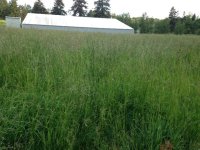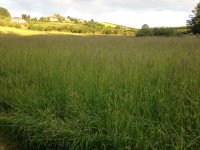It is important to have the hay at a proper moisture level or you will get mold inside the bales or worse possibly burn a barn down. The climate of the area that you live in plays a huge factor. The type of crops are also a factor (Leafy stuff takes more time to dry than grassy stuff).
What works for a guy in an arid dry heat climate like Texas is not going to work for a guy in a high humidity climate even if temps are otherwise similar. I am not familiar with Oregon climate so will pass on offering opinions about Oregon.
My experience of using crude and primitive haying equipment in Ohio (high humidity can be a problem in Ohio) of baling orchard grass, fescue, clover and a slight hint of alfalfla mix is to use my rake as an improvised tedder which signifigantly cuts down on the time needed to dry the hay (getting 4 days in a row without rain is rough in Ohio). Plus the other biggest benefit is I think you obtain a much better smell of hay along with the color. Putting up pleasant smelling hay is much more enjoyable than the alternative.
Anytime, I have let hay lay flat it gets bleached on top and smells damp and rank underneath when I leave it lay too long. On the other hand, if I use my rake to get the crop up into a fluffy windrow after about a day of sun exposure after cutting, then flip the windrow like a pancake 1/2 to 3/4 of a day later using the very tail tip of the rake to then turn my windrow and my hay always smells extremely pleasant to the human nose. Really wet hay and less optimum drying conditions will have me resorting to a 3rd trip over the field in the middle of my flippying the windrow trips where I use the rake tines like a beater to break up the wet clumps.
Now if I had an operational tedder then I would use that instead of the rake but my junkpile tedder still needs some refurbishment. No huge disadvantage to overworking non leafy hay crops as leaf loss is not a problem with grassy based crops - assuming you can tolerate the additional fuel and time to do it -neither of which should pose a problem on a small 3 acre patch. Hate to be the bearer of bad news but making a profit on 3 acres is going to be hard. I have yet to make a profit on 4.5 to 6 acres of hay but do enjoy doing it nonetheless. A masochistic hobby it is.
In short, If the stuff on top is dry and the stuff underneath is wet then you know what you need to do...flippying with the rake time it is...

